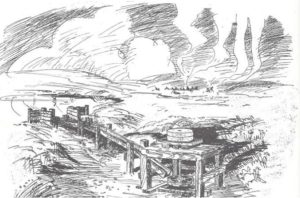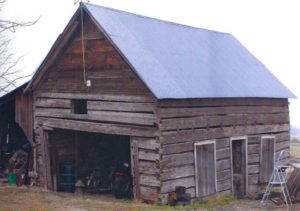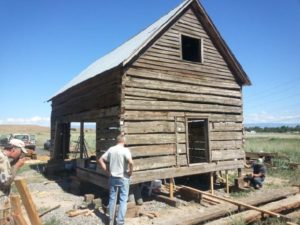Welcome to the Cayuse Village at Waiilatpu History Website

Cayuse village in the distance seen from Whitman Mission grist mill; Sketch by National Park Service artist.
Before the first Euro-Americans settled in the Walla Walla Valley, a winter village of the Cayuse Indians was located for many years in the vicinity of what later became the site of the Whitman Mission.
When Marcus and Narcissa Whitman established their Presbyterian Mission in the valley in 1836, the Cayuse Pásxa winter village was located about a quarter mile east of it, clearly visible and an easy walk from the Mission grounds.
The current Whitman monument, a granite obelisk on the hill above the Mission, overlooks the site of what was once the Pásxa Village to the southeast. This was a village of equestrians who welcomed the Whitmans and made room for them on their ancestral grounds, which were rich and productive grazing lands of native perennial grasses. Nearby a thermal spring which still remains active and never froze, was a popular spot for watering horses, especially during hard winters.
A Cayuse winter village was a place of tule mat longhouses and temporary dwellings where equipment was constructed and repaired, and oral traditions were shared during the long winter months. In other seasons of the year, most of the village’s inhabitants migrated to traditional upland hunting and gathering places, and to fish and dig roots in the spring, hunt and pick berries in the summer and fall, and occasionally cross the Rocky Mountains to hunt bison. The trek to the plains was recognized as an opportunity to expand trade to more interior peoples, and the Cayuse and Walla Walla became adept middlemen.
Historian Verne Ray has identified seventy-six traditional Cayuse Village sites, most temporary, seasonal sites. The extent of the Cayuse territory was vast. The Cayuse maintained villages on the Tucannon, Snake, Touchet, and Walla Walla Rivers in Washington, and the Umatilla, Grande Ronde, Burnt, Powder, and John Day Rivers in Oregon as well as on several Washington and Oregon Creeks. Ray identified five separate villages in the Walla Walla Valley and seven Cayuse Bands scattered throughout Eastern Oregon and Washington. The Walla Walla River Cayuse Band was called the Pa’cxapu.
The Prince’s Cabin
When Robin and Kriss Peterson purchased the Smith farmstead just east of the Whitman Mission in 1990, they became interested in the old cabin sitting amongst the farm buildings.
Robin was the minister of the College Place Presbyterian Church, taught French at Whitman College, and was also an active farmer. His passionate interest led him to investigate the history and origins of the cabin back to the Prince, the younger brother of the headman at the Cayuse village just east of the Whitman Mission. all of which he described in a paper he provided interested people and organizations, including the Frenchtown Historical Foundation. Robin’s goal for the cabin was to move it to a more prominent location on their place and to restore it for use as a center of reconciliation.
Following Robin’s death, in 2013 Kriss Peterson donated the cabin to the Frenchtown foundation on the condition that it be moved to the Frenchtown site to be restored and available for public display.
Moving & Restoring the Cabin
During the more than 100 years the property was owned by members of the Smith family, shed roofs were added on both the cabin’s north and south sides protecting it from deterioration. The east wall was also opened to allow farm equipment storage, and electrical wiring was added for its use as a playhouse and machine shop.
Beginning in 2008, the Petersons began efforts to prevent deterioration of the cabin, and to prepare it for moving.
To move and restore the cabin at the Frenchtown site, the Frenchtown Historical Foundation put together a team of contractors and volunteers. Although the upper floor of the cabin was intact, the partially dismantled and deteriorating lower walls were in six pieces. The first tasks were to prepare a new site for the cabin, to document the condition of the cabin and its contents before the move, and to decide how to move it without further damage.
In consultation with archaeologists, contractors, craftsmen, historians, tribal representatives, and movers, a decision was made to remove the remaining shed on the south side of the cabin, to move the upper story intact, to temporarily stabilize the lower wall segments instead of further dismantling them, and to move them separately—which proved to be a successful strategy.
More Details
For a detailed history of the Prince, the cabin, its design, and its moving and restoration, click here to visit the Frenchtown Historical Foundation website.
Interpretive Signage
An interpretive sign has been installed by Walla Walla 2020 on Last Chance Road just north of the Walla Walla River overlooking the original site of the village and the cabin. The cabin itself is now available for viewing at the Frenchtown Historic Site two miles west of the Whitman Mission seven days a week from dawn to dusk with no admission charge, and features additional signage. More information can also be found at http://www.frenchtownwa.org/ and at http://www.ctuir.org/.
Historic Sites & Markers Project
Thanks to Greg Cleveland, Jennifer Karson Engum, Robin Peterson, Mahlon Kreibel, Sam Pambrun, and others who contributed information shown on this page. Information on Walla Walla 2020’s Historic Research & Plaque Project honoring individual buildings and properties is also available at www.ww2020.net/historic-building-research.


